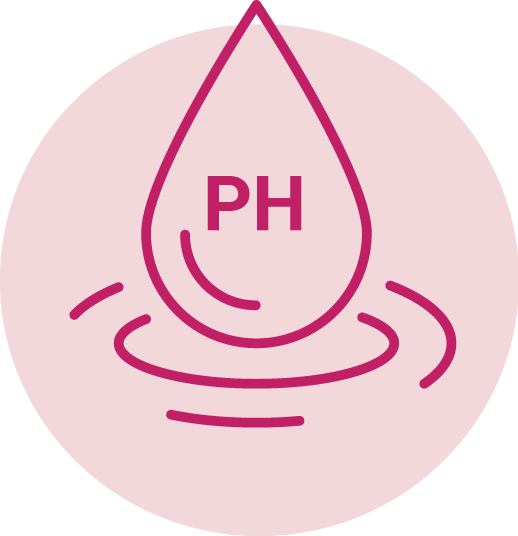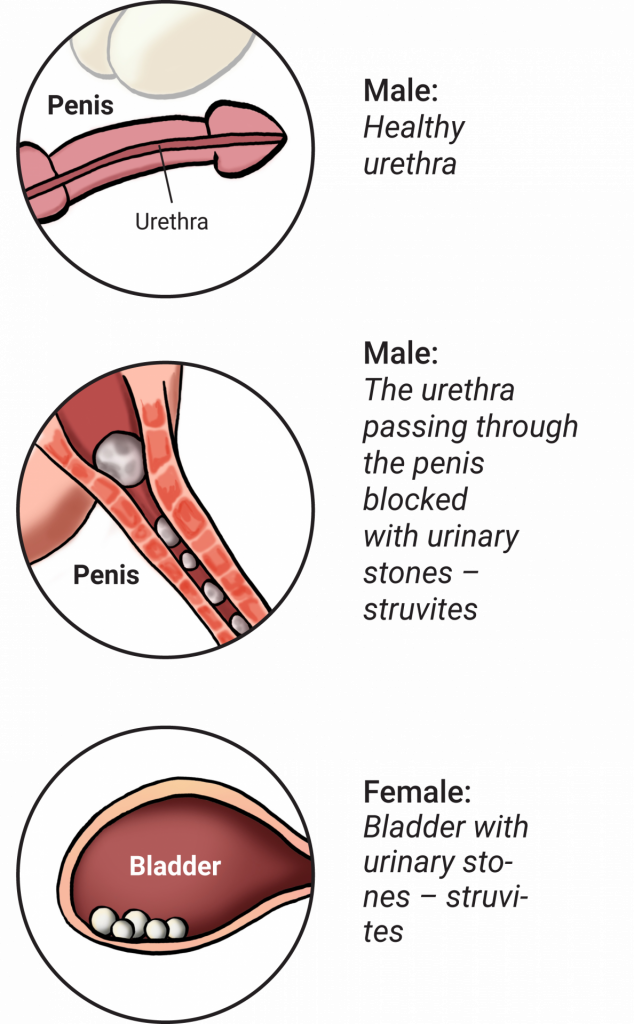Calibra VD Cat Struvite 2 kg
Veterinary Diets Consult with your vet
Intended use: dissolution of struvite stones, reduction of struvite stone recurrence, feline lower urinary tract disease
skip_main skip_menu skip_search
9 February, 2022
Urinary tract diseases are relatively common problems and health complications
in cats. The development of urinary tract infections and the formation of
urinary stones are conditioned by several factors – from breeding
predisposition through stress to diet. Calibra has developed veterinary diets
that help treat struvites – the most common type of urinary stone in cats.
This article will give you answers to:
Struvites are a type of urinary stone and belong to the most common kinds that occur in cats. Chemically, they are a compound made up of phosphate, ammonia, and magnesium. An alkaline pH (>7) contributes to their formation. This type of urinary stone can be completely dissolved using a special diet, and they generally do not require surgery (providing that animal is able to urinate).
In this case, the veterinary diet is the primary treatment. Thanks to the diet’s special formulation, urinary pH can be lowered (urine acidification), which is one of the factors that prevents the formation of further struvites and supports the dissolution of existing stones. The diet also dilutes the crystal-forming substances and promotes water intake. By diluting the urine, RSS (relative supersaturation) of mineral levels can be reached that enable existing struvites to dissolve. The prerequisite for success is a well-constructed diagnosis that clearly defines the type of stone and excludes bacterial infection.
In case of bacterial infection, targeted antibiotic therapy is needed. Regular clinical checks are necessary.
 What is normal urine pH for cats?
What is normal urine pH for cats?
Healthy cats have a urine pH of around 6.3 to 6.6. This value can vary based on diet. A protein diet (based on meat) lowers pH towards acidity (<7), while a plant-based diet raises (alkalizes) the urine’s pH.
FeLUTD (Feline Lower Urinary Tract Disease) refers to a disease of a cat’s lower urinary tract. This disease has many causes and can result in difficult urination or life-threatening complete blockage of the urinary tract and the inability to urinate.
The lower urinary tract includes the bladder and urethra. The upper urinary tract includes the kidneys and ureters.

 Obesity (neutered cats with a tendency to gain weight are at the highest risk)
Obesity (neutered cats with a tendency to gain weight are at the highest risk)Feline Idiopathic Cystitis is an inflammation of the bladder for which there is no apparent cause. It is a sterile inflammation – one that is not caused by any infection (viruses or bacteria). The onset of this disease can be attributed to stress. Cats are susceptible to stress and changes in their environment. Stress can activate the hormonal axis – the innate “fight or flight” instinct is triggered, releasing the hormones adrenalin and noradrenaline.These hormones prepare the body to fight or flight - the respiratory rate and pulse increase, blood flows to the brain, and as a result of this cascade, the flushing of hormones (called effectors) and mediators alters the permeability of the epithelium in the bladder. It also leads to a change in the structural components of the epithelium and to exposure of the nerve fibers, which are constantly irritated by urine.
The onset of this disease can be attributed to stress. Cats are susceptible to stress and changes in their environment. Stress can activate the hormonal axis – the innate “fight or flight” instinct is triggered, releasing the hormones adrenalin and noradrenaline.These hormones prepare the body to fight or flight - the respiratory rate and pulse increase, blood flows to the brain, and as a result of this cascade, the flushing of hormones (called effectors) and mediators alters the permeability of the epithelium in the bladder. It also leads to a change in the structural components of the epithelium and to exposure of the nerve fibers, which are constantly irritated by urine.
Long-term irritation causes inflammation, inflammation causes pain,and pain supports further stress...
Obese and inactive cats are at risk.
Fat tissue releases hormonal effectors that can trigger an inflammatory response and cause bladder inflammation. For this reason, cats must maintain a proper weight.
The condition of an animal’s body is evaluated, considering differences in breeds and sizes, using the Body Condition Score – an internationally recognized system. A cat is at its ideal weight when we can see a well-defined waist and body silhouette, and we can feel its ribs while cuddling.

 Urinary stones, or uroliths (the disease is called urolithiasis), are clusters of minerals that have crystallized due to changes in conditions in the urinary tract. Improper feeding, bladder inflammation, genetics, or other health factors can cause these changes.
Urinary stones, or uroliths (the disease is called urolithiasis), are clusters of minerals that have crystallized due to changes in conditions in the urinary tract. Improper feeding, bladder inflammation, genetics, or other health factors can cause these changes.
Crystallization occurs when the urine contains a large quantity of dissolved minerals
or the urine is too concentrated (low fluid intake, excretory tract problem).
Urinary stones can occur anywhere, but they usually form in the bladder or the urethra. Clinical symptoms then vary based on the location. The greatest danger is when a urinary stone blocks the urethra and the animal cannot urinate – this is a life-threatening condition.
Specific symptoms:
 Frequent urination (pollakiuria)
Frequent urination (pollakiuria)General symptoms:
 The cat gets in an unusual position when urinating.
The cat gets in an unusual position when urinating.In households with multiple cats, it is very easy to overlook these symptoms! Cats can hide signs of illness for a long time, and the full extent of the illness is often not apparent until it is too late. Therefore, it’s essential to pay close attention to each cat in the household.
 In general, a cat requires about 50 ml of water per 1 kg of body weight per day. For a cat weighing 5 kg, this means about 250 ml of water a day. Felines in the wild, however, are adapted to low water intake, because their environment is
In general, a cat requires about 50 ml of water per 1 kg of body weight per day. For a cat weighing 5 kg, this means about 250 ml of water a day. Felines in the wild, however, are adapted to low water intake, because their environment is
dry and hot, and they can meet their daily fluid requirements with moisture from their prey. Cats also have a higher urine density than dogs – they can concentrate it more and thus recover more water from their bodies.
If your cat eats wet food, it will drink less. If your cat eats dry food, however, it needs to drink more. Some cats are very particular about where they drink - they will drink only water flowing from the tap or a glass. In this case, we can support their water intake by using a water fountain for cats or whatever method they prefer.
Recommend to you
Veterinary Diets
Consult with your vet
Intended use: dissolution of struvite stones, reduction of struvite stone recurrence, feline lower urinary tract disease
Calibra VD Cat Struvite 2 kg
To dissolve struvites and reduce their formation:
To support treatment of FeLUTD syndrome, it contains:
When using a veterinary diet aimed at treating struvites, the veterinarian must check the cat regularly. The veterinarian will also determine the duration of such therapy. It is also essential to ensure that the cat has access to a constant supply of fresh water.
 …and finally...
…and finally...
www.calibradiets.eu
Vytištěno v říjnu 2021
Calibra VD Struvite for cats has been specially developed by veterinarians based on the latest scientific findings. The composition is tailored precisely to their needs. And because Calibra veterinary diets lie somewhere between medicine and food, they help support medical treatment in the most natural way.
Choose your preferred language